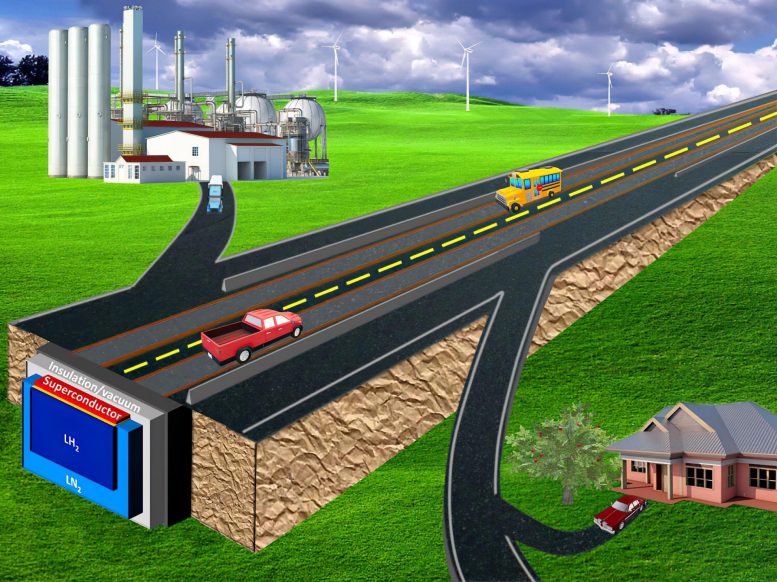
Schematic illustration of the superconducting highway for energy transport and storage and superconductor levitation for the transport of people and goods. Credit: Vakaliuk et al.
New Concept Would Offer Economic, Environmental Benefits for Next-Generation Transit, Energy Transmission, and Storage
Researchers have proposed a cost-effective superconductor system that integrates electrical power transmission and transportation using existing highway infrastructure. This concept could enable high-speed travel and provide a method for storing and transporting clean energy, offering significant long-term economic and environmental benefits.
For a long time, the promise of superconductivity for electrical power transmission and transportation has been held back by high costs. Now researchers from the University of Houston (UH) and Germany have demonstrated a way to cut the cost and upend both the transit and energy transport sectors by using superconductors to move people, cargo, and energy along existing highway infrastructure.
The combined system would not only lower the cost of operating each system but would also provide a way to store and transport liquified hydrogen, an important future source of clean energy. The liquified hydrogen would be used to cool the superconductor guideway as it is stored and transported, reducing the need for a separate specialized pipeline system capable of cooling the fuel to 20 degrees Kelvin, or minus 424 Fahrenheit.
The concept, described in a paper published on April 24, 2023, in the journal APL Energy, suggests a future in which air travel and traditional freight transport could become obsolete, replaced by a “super system” allowing personal and commercial vehicles to travel at speeds up to 400 miles an hour – maybe even twice that fast.
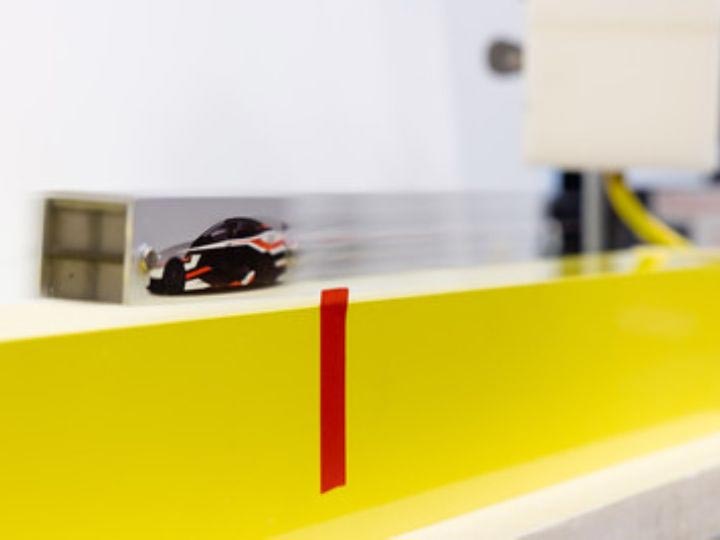
A levitated model car zooming over the model of the superconducting guideway in Ren’s lab at the University of Houston. Credit: University of Houston
“I call it a world-changing technology,” said Zhifeng Ren, director of the Texas Center for Superconductivity at UH, who came up with the concept and is a corresponding author on the paper. “Superconductivity has had such promise to transmit electric power without power loss, to power magnetically levitating, super-fast trains and for energy storage. But it has not been economically viable, which is why it hasn’t happened at large scale yet.”
The modern era of superconductivity research began in 1987, when a team led by UH physicist Paul Chu discovered a compound which acted as a superconductor at a temperature above the boiling point of liquid nitrogen. Since then, demonstration projects have proven that superconductors can be used to power magnetically levitated trains and to transmit electrical power without energy loss, reducing waste.
Technical details remain to be resolved, said Ren, who is also M.D. Anderson Chair Professor of Physics. “But the learning curve should not be steep since we have learned a lot during the past 40 years or so.”
Financing will be another challenge. And while this proof-of-concept paper does not include an economic analysis, he said combining transit and energy systems and using existing roadways would lower the cost substantially compared to that of any individual system. That, along with the project’s potential long-term economic and environmental benefits, would outweigh the upfront costs, he said.
Magnetically levitating trains traditionally operate on a magnetized rail, with superconductors embedded in the train undercarriage. This concept flips that, embedding superconductors into the existing highway infrastructure and adding magnets to the undercarriages of vehicles, which avoids having to cool the superconductors on each vehicle. Instead, the liquified hydrogen would cool the superconductors as it moves across the system, with liquified nitrogen and a vacuum layer used to thermally insulate the liquified hydrogen.
Researchers built a model to demonstrate the key technical aspect of the concept – levitating a magnet above a superconductor guideway. Liquified nitrogen was used to cool the superconductors in the model; Ren said future models will use hydrogen.
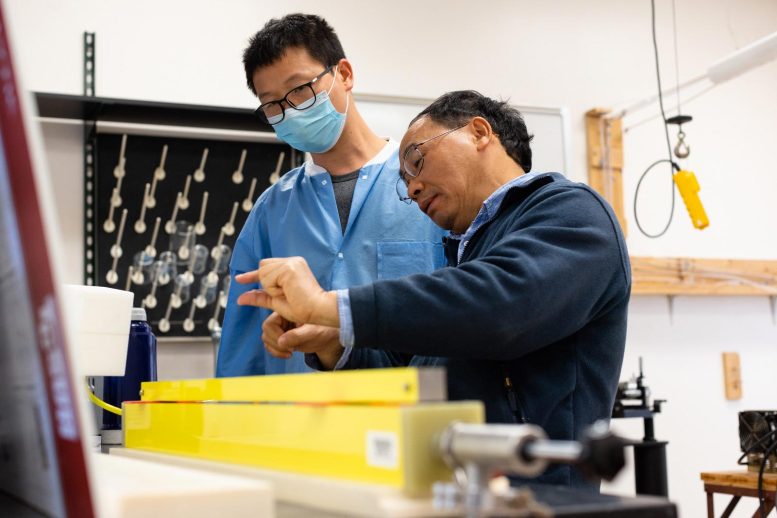
University of Houston researcher Zhifeng Ren discusses his concept of a superconductor-embedded highway with colleague Shaowei Song. His team has demonstrated proof of concept using a model. Credit: University of Houston
Vehicles with magnetized undercarriages – trains, cargo trucks, even personal vehicles – would enter the superconductor guideway, levitating and moving at high speed to reach their destinations. After leaving the guideway, vehicles would continue their trips powered by traditional electric or internal combustion motors.
People would be able to travel at their own convenience while enjoying the time-saving benefits of high-speed trains and air travel, Ren said. “Instead of 75 mph, you could go 400 mph, from Houston to Los Angeles, or Houston to New York in just a few hours.”
Fuel or electrical power consumption would drop dramatically while the car or truck was on the superconductor guideway, reducing both the cost and the environmental footprint, he said.
“All those benefits together, I think it could change the world.”
Reference: “A multifunctional highway system incorporating superconductor levitated vehicles and liquefied hydrogen” by O. Vakaliuk, Shaowei Song, U. Floegel-Delor, F. Werfel, Kornelius Nielsch and Zhifeng Ren, 24 April 2023, APL Energy.
DOI: 10.1063/5.0139834
In addition to Ren, co-authors on the project include Shaowei Song with the Texas Center for Superconductivity at UH; Kornelius Nielsch with the Leibniz Institute for Solid State and Materials Research in Dresden, Germany; and O. Vakaliuk, U. Floegel-Delor and F. Werfel, all with Adelwitz Technologiezentrum GmbH (ATZ) in Torgau, Germany, which specializes in high-temperature superconductivity material fabrication.



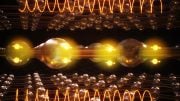
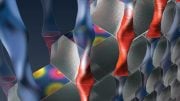



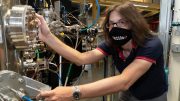
The morons cannot travel a normal highway safely at 40mph….at 400mph the population will be thinned out
Germany, the country that has no power os your country of choice? LMAO!!!!
While I applaud the effort and thinking behind this concept, some of it seems questionable or just not serious. A car moving at 400mph, in open air? What about a bird strike at that speed? Are cars of today capable of withstanding the aerodynamic forces at play at 400mph without rapid unplanned disassembly?
In general, having a complex, multi-component system like this would mean vastly more complex maintenance and much higher chances of just one thing failing. Something system like this would probably have the complexity akin to a modern high efficiency skyscraper per mile of corridor or the LHC. Would the proposed system have a parallel servicing corridor? What happens when something fails, and the car or energy transport can no longer be used until repaired? The support structure around such a system is critical to address any maintenance and repair such a complex system would undoubtedly require but isn’t even hinted at here.
Additionally, hydrogen is REALLY hard to contain in a closed system. Hydrogen leaks are guaranteed in such a large system and are notoriously hard to repair, especially in proximity to high voltage/amperage electricity. Think about repairing some leak next to a superconducting energy line where one spark could create a crater the size of a medium sized town! That job better have great benefits and life insurance.
Just some thoughts 🙂